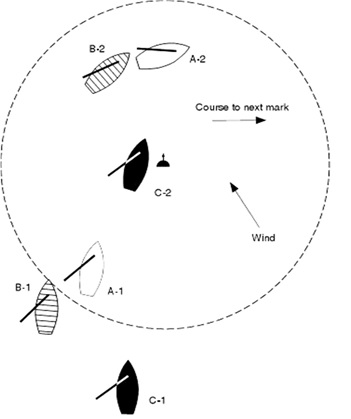



CASE 63
Definitions Mark-Room
Rule 18.2(b), Mark-Room: Giving Mark-Room
Rule 18.2(c)(2) , Mark-Room: Giving Mark-Room
Rule 43.1(b), Exoneration
At a mark, when space is made available to a boat that is not
entitled to it, she may, at her own risk, take advantage of the
space.

Facts
Two boats, A and B, broad reaching and about to leave a mark to starboard,
were overlapped with B outside. C was further astern. A passed the mark
about one hull length to leeward, as did B, leaving ample space for C to
round the mark inside them. B, because of her position outside A, was
unable to deny C that space, and at no time during the incident sailed a
course that would have resulted in a collision with C. No contact occurred.
B protested C.
The next leg of the course was a close reach on starboard tack to the next
mark (see direction to the next mark in the diagram).
The protest committee dismissed B’s protest stating that C did not break any
rule when she sailed between B and the mark and C did not cause B to take
avoiding action or prevent B from luffing. B appealed on the grounds that
C’s action prevented her from executing her intended manoeuvre, which had
been to slow down by bearing away and then to harden up across A’s
transom, thereby denying space to C to pass inside.
Decision
B’s appeal is dismissed.
Rule 12 (and later rule 11) required C to keep clear of B. When B reached
the zone at position 1, she was clear ahead of C so rule 18.2(b) required C
to give B mark-room. C complied with those rules.
After C became overlapped inside B, C was also required by rule 18.2(c)(2)
to give B room to sail her proper course. However, because B was
overlapped outside A, B was prevented by A from sailing any closer to the
mark than she did. As a result, there was ample space for C to sail between
B and the mark without preventing B from sailing her proper course.
Therefore, C did not break rule 18.2(c)(2).
When a boat voluntarily or unintentionally makes space between herself and
a mark available to another that has no right to such space, the other boat
may take advantage, at her own risk, of the space. The risk the other boat
takes is that the boat entitled to mark-room may be able to close the gap
between herself and the mark while sailing her proper course. In that case,
the boat entitled to mark-room is exonerated by rule 43.1(b) if she breaks a
rule of Section A or rule 15 or 16, and only rule 14 will limit her course if
she makes a rapid and aggressive attempt to close the gap between herself
and the mark.
GBR 1984/1






